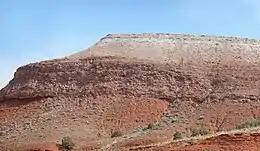Ellis Group
The Ellis Group is a stratigraphical unit of Bajocian-Oxfordian age in Alberta, Saskatchewan, Montana and Wyoming in the Western Canadian Sedimentary Basin. It takes the name from Fort Ellis, Montana, and was first described in outcrop in the Rocky Creek Canyon by A.C. Peale in 1893.[2]
| Ellis Group | |
|---|---|
| Stratigraphic range: | |
| Type | Geological group |
| Sub-units | Swift, Rierdon, Piper & Sawtooth Formations |
| Underlies | Mannville Group |
| Overlies | Rundle Group & Shaunavon Formation |
| Thickness | up to 150 m (490 ft)[1] |
| Lithology | |
| Primary | Shale, sandstone |
| Other | Siltstone, limestone |
| Location | |
| Coordinates | 48.0°N 108.6°W |
| Approximate paleocoordinates | 40.9°N 49.2°W |
| Region | Alberta, Saskatchewan Montana, Wyoming |
| Country | |
| Extent | WCSB |
| Type section | |
| Named for | Fort Ellis |
| Named by | A.C. Peale |
| Year defined | 1893 |
 Ellis Group (Canada) | |

Lithology
The Ellis Group is composed of shale and sandstones deposited in a marine and transitional environment. [1]
Hydrocarbon production
Oil is produced from the Sawtooth Formation in southeastern Alberta.
Distribution
The Ellis Group laterally occurs in the subsurface in southern Alberta and northern and central Montana.[1] It is typically 80 metres (260 ft), but thickens on either side of the Sweetgrass Arch and reaches up to 150 metres (490 ft) in southeastern Alberta.
Subdivisions
The Ellis Group includes the following formations, from top to bottom:
| Sub-unit | Age | Lithology | Max. Thickness | Notes |
|---|---|---|---|---|
| Swift Formation | Oxfordian | marine shale, transitional shale, siltstone and sandstone | 41 m (130 ft) | |
| Rierdon Formation | Bathonian to Callovian | marine shale and limestone | 60 m (200 ft) | |
| Sawtooth Formation | Bajocian to Bathonian | quartzose sandstone with shale | 41 m (130 ft) | |
| Piper Formation | Middle Jurassic | sandy limestone (top) papery shale siltstone and shale grey limestone white gypsum (base) | 23 m (80 ft) | |
Relationship to other units
The Ellis Group is unconformably overlain by the shales and sandstones of the Mannville Group and rests on the carbonates of the Rundle Group. It grades westwards to the shales of the Fernie Group, and eastwards to the shale, sandstones and limestones of the Vanguard and Shaunavon Formations.[1]
References
- Lexicon of Canadian Geologic Units. "Ellis Group". Archived from the original on 2013-02-21. Retrieved 2010-01-01.
- Peale, A.C., 1893. The Paleozoic section in the vicinity of Three Forks, Montana. United States Geological Survey, Bulletin 110, p.9-56.
- Lexicon of Canadian Geologic Units. "Swift Formation". Archived from the original on 2012-07-09. Retrieved 2010-01-03.
- Lexicon of Canadian Geologic Units. "Rierdon Formation". Archived from the original on 2012-07-07. Retrieved 2010-01-03.
- Lexicon of Canadian Geologic Units. "Sawtooth Formation". Archived from the original on 2012-07-07. Retrieved 2010-01-03.
- Lexicon of Canadian Geologic Units. "Piper Formation". Archived from the original on 2012-07-08. Retrieved 2010-01-03.